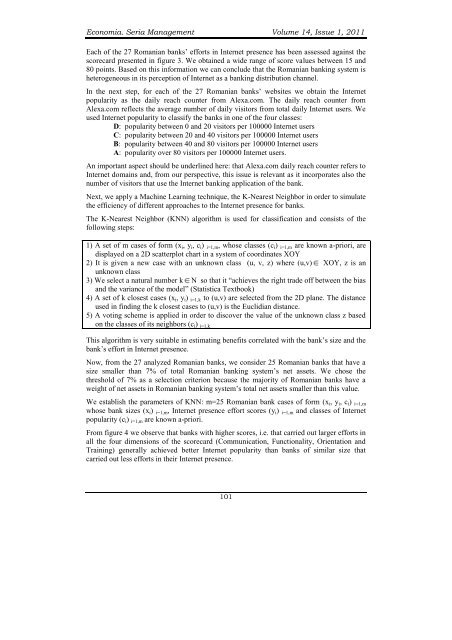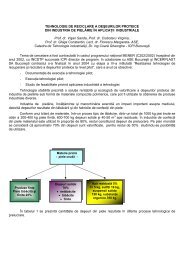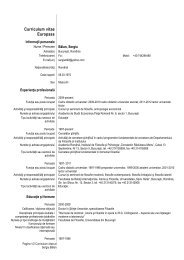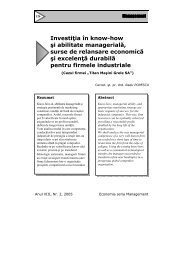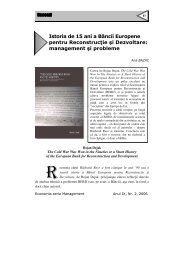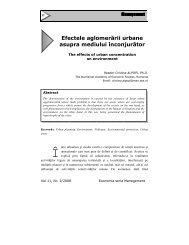Norlizan MAT RABI, Abdul Hadi ZULKAFLI, Mohd Hassan CHE HAAT
Norlizan MAT RABI, Abdul Hadi ZULKAFLI, Mohd Hassan CHE HAAT
Norlizan MAT RABI, Abdul Hadi ZULKAFLI, Mohd Hassan CHE HAAT
You also want an ePaper? Increase the reach of your titles
YUMPU automatically turns print PDFs into web optimized ePapers that Google loves.
Economia. Seria Management Volume 14, Issue 1, 2011<br />
Each of the 27 Romanian banks’ efforts in Internet presence has been assessed against the<br />
scorecard presented in figure 3. We obtained a wide range of score values between 15 and<br />
80 points. Based on this information we can conclude that the Romanian banking system is<br />
heterogeneous in its perception of Internet as a banking distribution channel.<br />
In the next step, for each of the 27 Romanian banks’ websites we obtain the Internet<br />
popularity as the daily reach counter from Alexa.com. The daily reach counter from<br />
Alexa.com reflects the average number of daily visitors from total daily Internet users. We<br />
used Internet popularity to classify the banks in one of the four classes:<br />
D: popularity between 0 and 20 visitors per 100000 Internet users<br />
C: popularity between 20 and 40 visitors per 100000 Internet users<br />
B: popularity between 40 and 80 visitors per 100000 Internet users<br />
A: popularity over 80 visitors per 100000 Internet users.<br />
An important aspect should be underlined here: that Alexa.com daily reach counter refers to<br />
Internet domains and, from our perspective, this issue is relevant as it incorporates also the<br />
number of visitors that use the Internet banking application of the bank.<br />
Next, we apply a Machine Learning technique, the K-Nearest Neighbor in order to simulate<br />
the efficiency of different approaches to the Internet presence for banks.<br />
The K-Nearest Neighbor (KNN) algorithm is used for classification and consists of the<br />
following steps:<br />
1) A set of m cases of form (xi, yi, ci) i=1,m, whose classes (ci) i=1,m are known a-priori, are<br />
displayed on a 2D scatterplot chart in a system of coordinates XOY<br />
2) It is given a new case with an unknown class (u, v, z) where (u,v) XOY, z is an<br />
unknown class<br />
3) We select a natural number k N so that it “achieves the right trade off between the bias<br />
and the variance of the model” (Statistica Textbook)<br />
4) A set of k closest cases (xi, yi) i=1,k to (u,v) are selected from the 2D plane. The distance<br />
used in finding the k closest cases to (u,v) is the Euclidian distance.<br />
5) A voting scheme is applied in order to discover the value of the unknown class z based<br />
on the classes of its neighbors (ci) i=1,k<br />
This algorithm is very suitable in estimating benefits correlated with the bank’s size and the<br />
bank’s effort in Internet presence.<br />
Now, from the 27 analyzed Romanian banks, we consider 25 Romanian banks that have a<br />
size smaller than 7% of total Romanian banking system’s net assets. We chose the<br />
threshold of 7% as a selection criterion because the majority of Romanian banks have a<br />
weight of net assets in Romanian banking system’s total net assets smaller than this value.<br />
We establish the parameters of KNN: m=25 Romanian bank cases of form (xi, yi, ci) i=1,m<br />
whose bank sizes (xi) i=1,m, Internet presence effort scores (yi) i=1,m and classes of Internet<br />
popularity (ci) i=1,m are known a-priori.<br />
From figure 4 we observe that banks with higher scores, i.e. that carried out larger efforts in<br />
all the four dimensions of the scorecard (Communication, Functionality, Orientation and<br />
Training) generally achieved better Internet popularity than banks of similar size that<br />
carried out less efforts in their Internet presence.<br />
101


